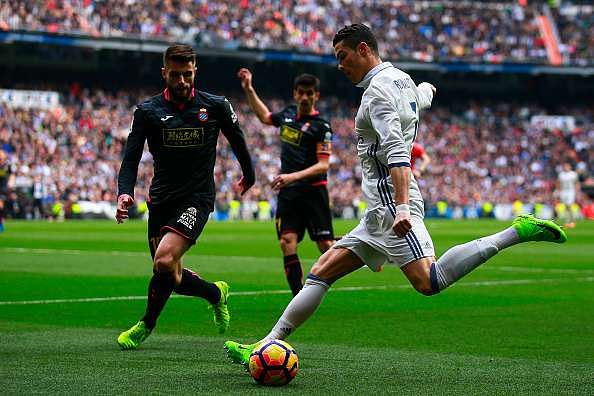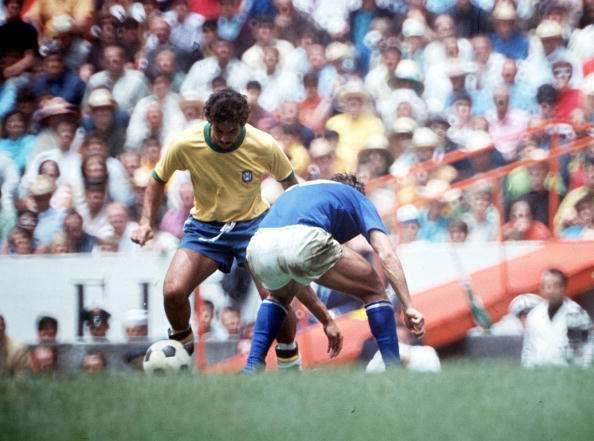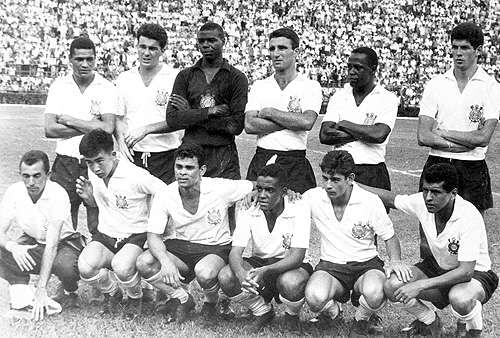
Cristiano Ronaldo, Rivellino and the forgotten history of the Elastico
Cristiano Ronaldo caused a minor stir on Saturday night when he outrageously beat Espanyol defender David Lopez during Real Madrid’s 2-0 win.
27 minutes on the watch, with the score reading 0-0, the four-time Ballon d’Or winner picked up a pass on the left-hand side of the area and started manoeuvring his way towards the goal. In his path was David Lopez, the Spanish central defender. Normally, any player would have tried to hit an early cross under pressure or play the ball backwards. But Ronaldo is not ‘any’ player.
The Portuguese forward displayed a moment of brilliance in which he executed a magical elastico nutmeg, also known as a flip-flap in some areas, and left Lopez in his wake.
Sure, the move did not yield any immediate results as Ronaldo soon relinquished possession, but it was a show of sheer magic, a moment that will forever be etched in the history books of football and his career.
That said, while Ronaldo may have fast feet, he lacks the steady composure of the great Rivellino.
The ‘inventor’, Rivellino, and his lesser-known teammate, Sergio Echigo
The elastico, or flip flap, which Ronaldo performed on Saturday night, was one of the stock moves of one moustachioed trickster, Roberto Rivellino – the star of three World Cups for Brazil and widely considered the inventor of the magical move. Later on, of course, it was globalised by Ronaldo Nazario, the executioner, and Ronaldinho, the undisputed master.
It surely has to be the most Brazilian of all tricks. Only a Brazilian (or so we thought) has it in him to execute the snake-like movement – ball glued to the feet, slithering from one side to the other with just the drop of the shoulder and the swish of the boot.
And Rivellino was the first one to perfect it. He lived and breathed to tease and torment defenders. The left-footed genius often used the move on the pitch to set up a teammate and occasionally, to take a rifled shot at goal. A tentative yet deft little flick to the left and then the obligatory darting switch back inside and woosh, the defender was left scrambling.
Although Rivellino may have mastered the trick, it was one Japanese-Brazilian youth team associate of his, whom we have to thank too. How is that for confounding expectation, for the flip-flapping convention?
The elastico is not the intellectual property of Rivellino, or for that matter, not even Brazil’s. Instead, thank Sergio Echigo. Sergio, who?
Born to Japanese immigrant parents in Sao Paulo, Echigo excelled as a footballer on the streets of the Brazilian city. He quickly climbed up the ranks and joined Corinthians as a teenager in 1963. Known for his quick feet, skilful dribbling, and explosive pace, he soon made a name for himself at the club. By his 20th birthday, he had already made over a dozen appearances for Corinthians.
An unspectacular career, however, was to follow. It was only after he moved to his native Japan, that Echigo would impress again. He became one of the best players of the country before retiring in 1974 to pursue a career in coaching. Nowadays, he is a famous commentator and a respected football pundit in Japan.
His greatest legacy, however, lies in Brazil, in the Corinthians training ground where one of his teammates was none other than Rivellino.
Echigo and Rivellino were similar in many aspects. Both of them were of the same age, both were the sons of immigrants and both were masters of a new-fangled skill, the elastico. No one had ever seen it before.
Although Rivellino was always the better overall footballer, it was Echigo who chanced on the trick first.
“I learned the move from a player called Sergio Echigo, who played with me in the Corinthians youth team in ‘64. He invented that trick. I saw him do it once and I said, ‘Hey, Japanese, what’s that trick?’ He said, ‘It’s easy Rive, I’ll teach you it,’ and he says now that he invented it, but I perfected it”, Rivellino had later conceded.
Of course, it was the Brazilian great who later perfected it. And it would eventually become his trademark move.
When national coach Mario Zagallo shifted Rivellino to the left flank to accommodate an irrepressible front four with him, Jairzinho, Pele and Tostao at the 1970 World Cup, the elastico came to the forefront. Rivellino would often use the trick to dazzle the opposition defenders at the tournament. Even in that famous rout of Italy in the final, he executed the trick with perfection.
A slight movement one way, and then quickly the other, as the ball duly zipped through the defender’s widespread legs. Then came the hop around the fallen defender to collect the ball, as if to crown the superb triumph.
Obviously, most of the defenders would fall foul of that particular wonder-skill. Yes, it was Rivellino’s signature indeed. So much so that today, he is credited as its inventor. Even Pele had said, “(The move) was something (Rivellino) created… a trick that only Rivelino could do.”
And all this while poor Sergio Echigo remains long forgotten.
The Algerian flip-flapper, Salah Assad
As does the elastico-loving Algerian, Salah Assad. The skilful attacking player was adept either as a centre-forward or as a winger. He played in two World Cups for his nation and became Algeria’s leading scorer in World Cups.
Assad would, in fact, also go on to tread outside his politically volatile homeland and play at French side FC Mulhouse and later Paris Saint-Germain. Unfortunately, things did not go as well as he would have hoped and after another brief stint at Mulhouse, he returned back to his native country.
The forward would later spend four years in custody for alleged association with the Front Islamique de Salud movement, which highlights how fraught with danger Algeria was at a certain time. Assad, for his part, maintained that he was never charged, never believed in violence, but simply practised his religion.
On the pitch, Assad was the true heir to Echigo. Although immensely talented, it was that one particular trick that garnered all the attention yet again.
The flip flap, or as known to the Algerians, el ghoraf, was his trademark move, much like Echigo and Rivellino. In fact, Assad said that he would use it so often that he could not recall which ghoraf was his best. He claimed that he did not pick up the trick from Rivellino but came up with it while playing with bottles and stones as a five-year-old.
The technique he used was different from that of the Brazilians. To quote Assad, Rivellino would perform the trick ‘on the spot’, i.e. while standing still or near still. On the other hand, the Algerian could perform it whilst at full speed – and he often did.
Jumping back to the present, though, today, neither Echigo nor Assad is remembered by many as the pioneers of the move. There are YouTube tutorials teaching everyone to do the perfect flip-flap, just like Cristiano Ronaldo. We see videos of the trick used by the ‘original’ Ronaldo to bamboozle Alessandro Nesta in the final of the 1998 UEFA Cup.
And, of course, we see numerous videos of Ronaldinho, the man we think of as the pioneer of flip-flapping, sending defenders into a frenzy every time he executed the trick at such break-neck speeds.
We never hear of Sergio Echigo or Salah Assad. However, as the elastico enters modern footballing consciousness, we laud its ‘inventor’ and its modern-day masters.
But this is to the forgotten Assad. This is to the forgetten Echigo. In football, not everything is as it seems, much like life.



